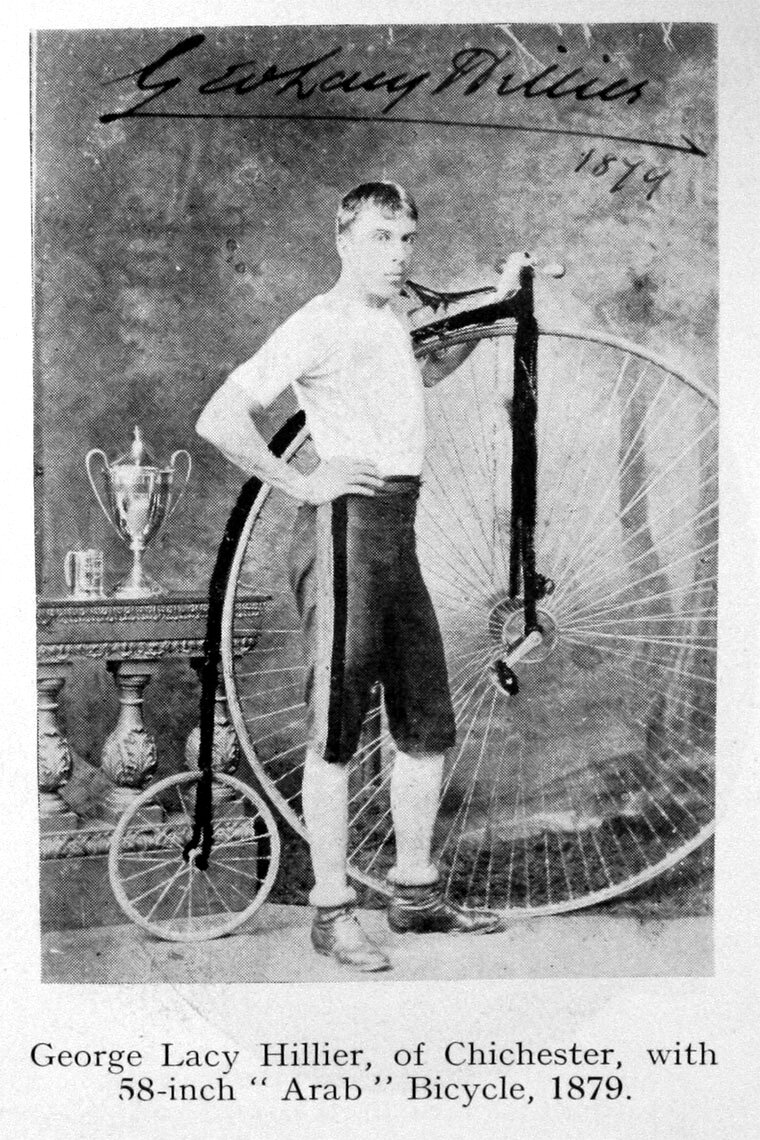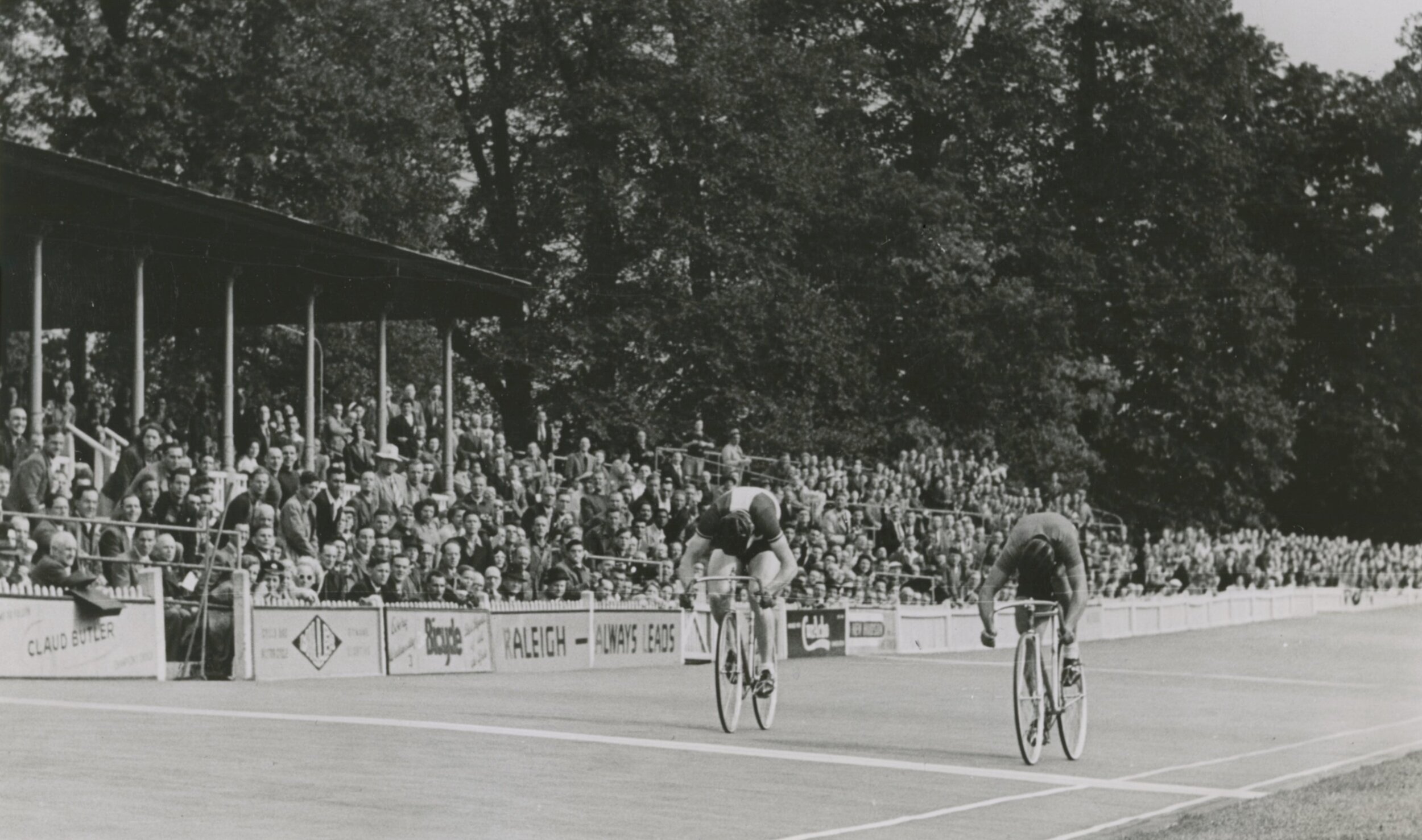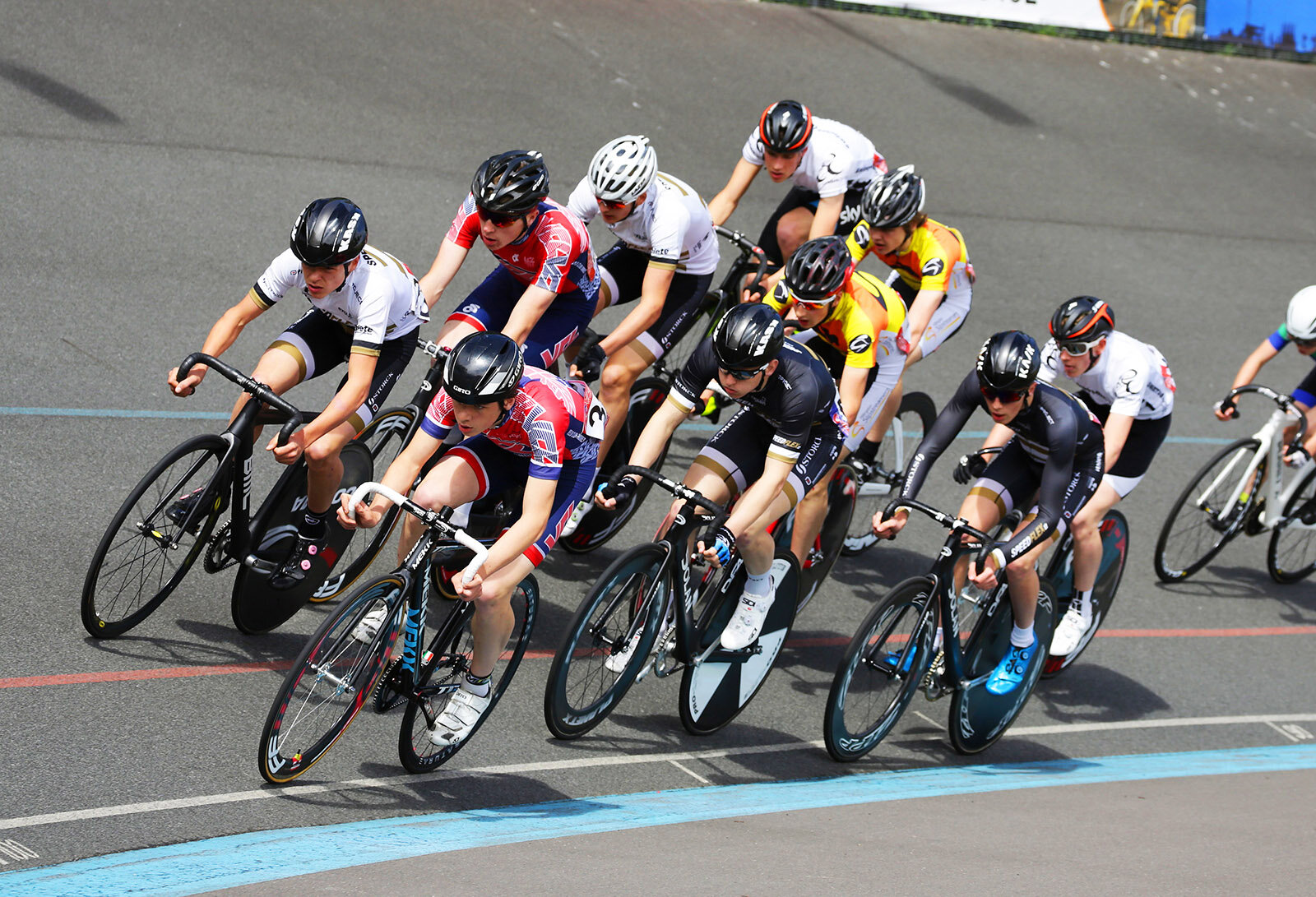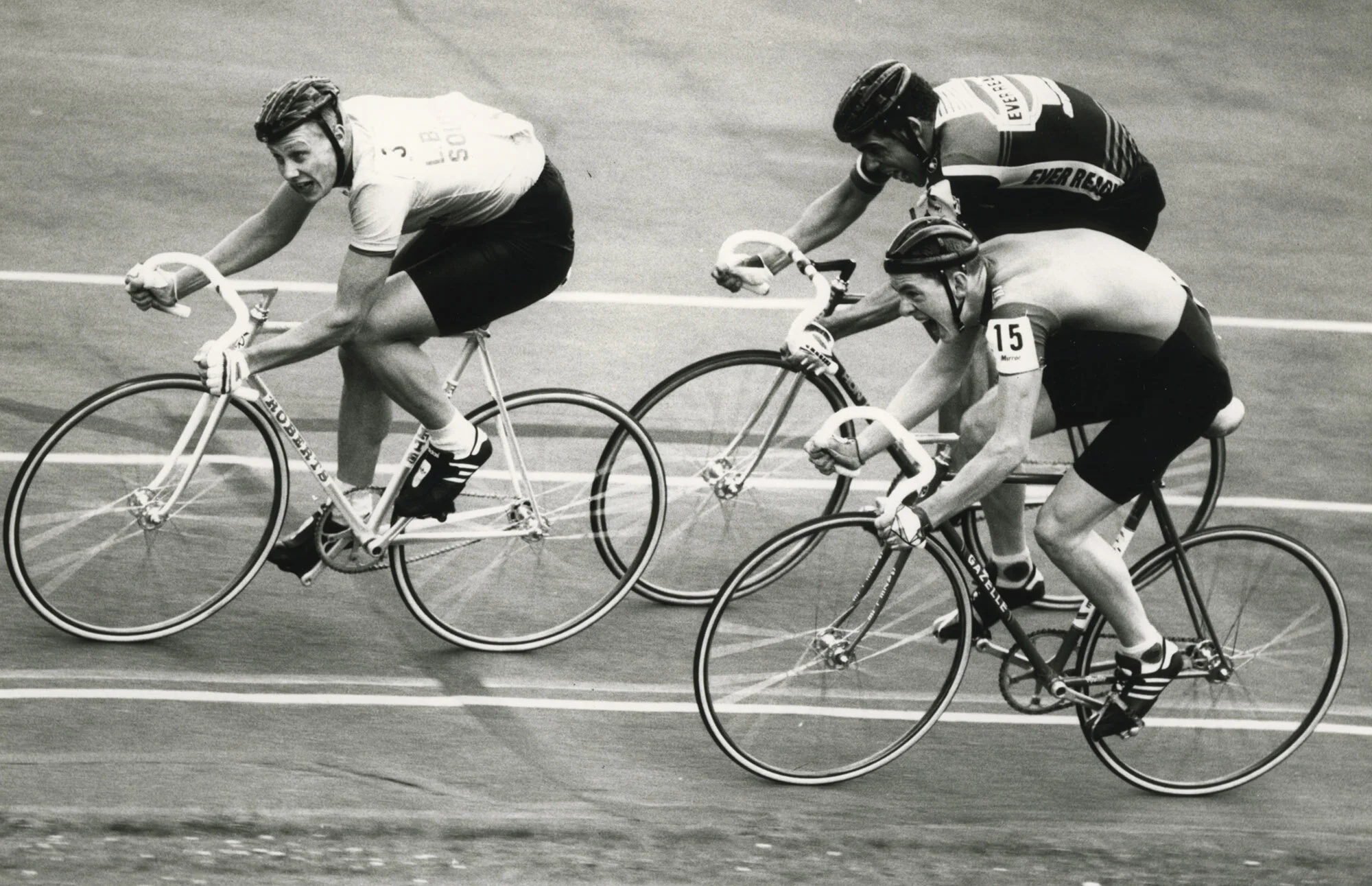
THE HISTORY OF HHV
Herne Hill Velodrome has a long and illustrious history, which we’ve attempted to briefly summarise on this page.
For a more detailed account we’d recommend reading Ride! Ride! Ride!: Herne Hill Velodrome and the Story of British Track Cycling by HHV regular Mark Wellings, available from the FHHV webshop.
1891 - HHV is built / 1948 - HHV hosts the Olympics / 2005 - Recent history

1891 - Herne Hill Velodrome is built - and thrives
1880s
Road racing on bicycles is outlawed, with residents of sleepy villages outraged by noisy groups of furious pedallers. The National Cyclist's Union asks its clubs to restrict racing to closed tracks. Other riders continue to race on roads in secretive, early morning individual time trials.
George Lacey Hillier with his 58 inch wheeled ‘Arab’ Bicycle, 1879. George - a top amateur racer - founded Herne Hill Velodrome and is buried in nearby Brockley and Ladywell Cemetery.
1890s
The popularity of bicycles booms with the invention of the Safety Bicycle and pneumatic tyre.
1890
Construction of a new cycle track as part of the London County Cycling and Athletics Ground begins. It is built on the site of a former dairy farm, on land owned by the Dulwich Estate, established by Elizabethan actor Edward Alleyn.
The project is championed by race promotor George Lacy Hillier and financed by local Brixton-based building company the Peacock family. The track was one of over 10 in London, and described as "a really first-class track" and "the fastest track in the world" measuring 504 yards (480m), 3 and a half laps to the mile.
1891 - 16th April
The first race is held, contested by members of the London County Cycling and Athletics Club.
1891 - 23rd May
Official public opening race meeting.
1890s & 1900s
Paced cycle racers are the fastest men on earth. Huge crowds flock to see riders paced by multi-manned Tandems reaching speeds up to 55mph.
Triple Pacing, early 1900s. This photo was taken from album of images collected by Charles Stewart Rolls (1877-1910, co-founder of the Rolls-Royce Company), showing the Cambridge University triplet of Kenny, Stewart and Rolls pacing Bennet in a 24-hour cycle race. Photo courtesy of SSPL
1900s
The first houses are build on Burbage Road, with more added on surrounding roads over the following decades, gradually surrounding the track and creating an oasis of open space.
1908
The first annual season-closing Meeting of Champions, which ran for over 50 years.
1911
The FA Amateur Cup final is held at Herne Hill, between Bromley and Bishop Auckland.
Women’s Race Start, 1900s. Women’s cycling has always been - and always will be - an integral part of Herne Hill Velodrome. Photographer unknown.
1914-18
Racing temporarily declines as involvement in the First World War discourages sport as a distraction against the war effort. Most able men are gradually conscripted and many return as casualties. Crystal Palace FC relocate to Herne Hill while their ground is requisitioned by the military.
1920s
Herne Hill Stadium is the country's premier track, regular drawing crowds of 10000 to major events.
1920s. Crowds queue down Burbage Road
1936
The first Monday Competition is held, featuring races for local sprinters. It featured two categories for different abilities of rider and would later extend to include distance events and a Wednesday Comp too. Top local amateurs would be invited to compete against the professionals at the spectator-filled weekend events.
A stayer race, 1930s. The Triumph motorbikes were adapted to give the driver a more upright position, while the riders’ bikes had a shorter - and lower - front end, allowing them to benefit from the slipstream. Photo courtesy of Cycling Weekly
1939-45
Herne Hill used as a barrage balloon site and allotments during the Second World War. Competitive sport dwindles during the war, and the few races still happening at other tracks in London are used as fund raisers for the war effort.
1945
The track is resurfaced and weeds cleared after years of neglect. The National Cyclists' Union takes on the lease of the velodrome from the Peacock family. The Good Friday meeting is the first public event, just a month before VE day. The official Grand Reopening meeting was held later on 23rd June.

1948 - The Olympics come to Herne Hill Velodrome
Sprint Semi-final, Olympic Games, 1948. Eventual winner, Italy’s Mario Ghella, beats Denmark’s Axel Schandorff (who went on to win bronze) Photographer unknown. Photo courtesy of Cycling Weekly
1948
Herne Hill hosts the first Olympics since the war, known as the 'Austerity Games'. The British Team win 2 Silvers in the Individual and Tandem Sprint, and 2 bronzes in the 1000m Time Trial and Team Pursuit. Herne Hill is the only surviving sports venue from the 1948 Olympics.
1959
London County Council take on the lease of the track. The professional spectacle of track cycling begins to wane, as road racing is finally permitted again. Herne Hill's focus shifts to community use. Over 10000 school children use it each year throughout the 1960s
Fausto Coppi leads the bunch at an exhibition race at HHV in the 1950s. Photo courtesy of Cycling Weekly
1964
Velo Club Londres is established as the first club in the area to provide racing opportunities for under 18s.
1970
A new velodrome is built in Leicester ahead of the World Championships. This marks the beginning of the transition for velodrome standards towards tracks that are smaller, wooden and eventually housed indoors
Champagne Meeting, 1987. Bruce Drew (left), Russell Williams and Chris Boardman (No.15) battle it out round turn four at the annual Champagne Meeting. Photo courtesy of Cycling Weekly
1990
The GLC and Inner London Educational Authority are disbanded and the lease of Herne Hill transfers to Southwark Council, and eventually their leisure provider, Fusion.
1992
Herne Hill is completely remodelled with funding from the Sports Council. The track shape and size changes to a slightly shorter 450m, with even length straights and curves, steeper 26 degree banking and a white epoxy-resin surface.
With Paddington closing in 1987, Herne Hill is now the only velodrome in London. It is now known as Herne Hill 'Velodrome', rather than 'Stadium'.
1992
Chris Boardman wins British Cycling's first cycling Olympic gold medal in 72 years at the Barcelona Olympics, and interest in track cycling starts to renew, ahead of a gold medal rush, starting the following decade.
1995
The first ever public cyclocross race at Herne Hill.
2001
Herne Hill Youth Cycling Club is established to offer off-road cycling sessions for children.
Stuart O’Grady, Good Friday Meeting, 2003. Former Olympic, World and Commonwealth Gold Medalist Stuart O’Grady entertains spectators at the historic Good Friday Meeting. Photo courtesy of London Cycle Sport. Photographer unknown

2005 onwards - Closure, fundraising and the cycling boom
2005 - January 1st
A decade of low usage numbers and poor upkeep mean the lease is not renewed. The track gates are locked and the pavilion declared derelict. Special permission is granted to open for the Good Friday meeting.
2005 - August 5th
A deal is struck with British Cycling taking on a temporary lease. The velodrome is managed on their behalf by a team of volunteers from VC Londres, with the vision 'run by cyclists, for cyclists of all ages and abilities'.
Future Champions. Jo Rowsell Shand and Laura Kenny - Olympic, World and European champions - cut their teeth in VCL colours. Photographer unknown
2008
After the Beijing Olympic success in track cycling, Herne Hill has never been so popular with new riders wanting to try out the track.
2010
The Save the Velodrome campaign launched with the aim of securing a sustainable future for Herne Hill.
2011
Funding from British Cycling replaces the cracking and slippery track surface with an all- weather tarmac one, as well as installing a new, safer track fence.
2012
London hosts 2012 Olympics and Team GB achieves its most successful medal haul since 1908. 12 of those medals come through cycling, with 7 golds in the track cycling events at the new velodrome in Stratford.
While not hosting any events this time, Herne Hill features prominently in news reports and promotion, and again sees a massive surge in new riders wanting to try track cycling.
2013
Junior track, multi-use games area and perimeter lighting are built, through Southwark’s Olympic Legacy Fund. This is the first time Herne Hill has been lit since the pre-war gas lamps.
Trackstanding at the Track League Finale, 2017. With floodlights installed, track competition - of all kinds - can continue well into the evening at Herne Hill Velodrome. Photo courtesy of Sam Holden
2016
A 99 year Lease is signed with the Dulwich Estate securing the future of the site.
2017
Funded by Sport England, London Marathon Trust, Mayor’s Fund and Southwark Council, the new pavilion is opened and The Big Finish crowdfunding campaign - supported by hundreds of HHV users - raises £89,184 in a matter of weeks to furnish it. This restores Herne Hill as a fit for purpose venue, to serve its vibrant and thriving community.
Team Elimination Race, FHHV Youth Team Champs, 2015. Within two years, four of the riders pictured would be national champions, two of those would also be European champions and one would be world champion. Photo courtesy of Sam Holden
2020
With Jan’s Cafe thriving in the pavilion, major investment from the Rapha Foundation, a strong race scene and user numbers on the rise, the future is looking good at Herne Hill Velodrome.
A big thank you to Jason Cattermole, who originally produced this timeline for the interior of the pavilion at HHV. For a more in-depth history of HHV, we’d recommend reading Mark Welling’s ‘Ride, Ride, Ride!’, available from the FHHV webshop.









